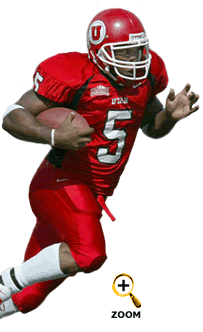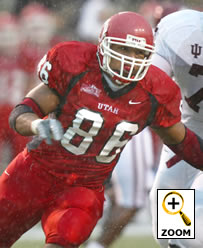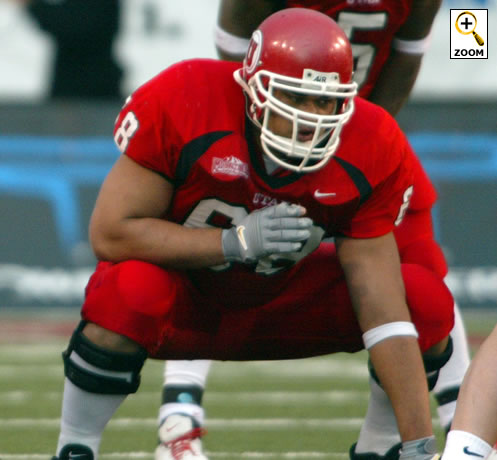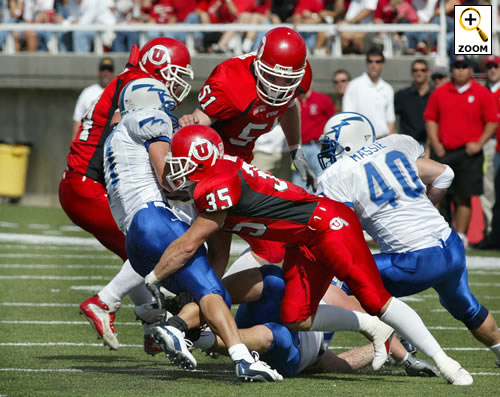 |
| TB
Brandon Warfield |
|
|
|
2002
Statistics
|
Coach:
Urban Meyer
1st
year |
|
2002
Record: 5-6
|
|
| at
Utah State |
WON
23-3 |
| INDIANA |
WON
40-13 |
| at
Arizona |
LOST
17-23 |
| at
Michigan |
LOST
7-10 |
| AIR
FORCE |
LOST
26-30 |
| at
San Diego State |
LOST
17-36 |
| COLORADO
STATE |
LOST
20-28 |
| at
New Mexico |
LOST
35-42 (2OT) |
| UNLV |
WON
28-17 |
| at
Wyoming |
WON
23-18 |
| BRIGHAM
YOUNG |
WON
13-6 |
|
2002 Final Rankings
AP-UR, Coaches-UR, BCS-UR
|
|
2003
Outlook
|
|
This
won't be your dad's Utah offense. The grueling,
plodding ground game of former coach Ron
McBride has been replaced by new coach Urban
Meyer's spread offensive approach. But don't
expect to see the same high-octane attack
Meyer showed at Bowling Green. Not this
year, anyway. With personnel more suited
to McBride's power game, expect a slow integration
toward Meyer's dual-threat, fast-paced scoring
machine. Utah already has lost a slew of
(mostly reserve) players to transfers when
they realized they wouldn't fit.
Look
for Meyer to spread defenses out with three-
and four-receiver sets, then thump bruisers
Brandon Warfield and Marty Johnson through
creases up front. If healthy and his medical
redshirt comes through, Johnson's tremendous
talent should command the majority of hand-offs.
Plus, Utah just doesn't have the personnel
in place (yet) to be a dangerous gun-slinging
pass offense. But the mix of run and pass
should marginally succeed, regardless. Meyer
won't ask the starting QB to do anything
incredible, but he'll have to avoid mistakes
and be a good game manager. The Utes will
be more than happy to put football games
in the hands of a good running game and
stout defense. That starts with a quarterback
who'll take a sack, throw a pass way or
milk the play clock when necessary.
On
the other side of the ball, six starters
are gone from a good unit. But what's left
isn't bad. The Utes again should be one
of the country's better-run defenses. It's
stopping the pass that could be trouble.
They'll need big seasons out of a top-shelf
front-four, which will be responsible for
creating much of the pass rush and running-lane
disruptions. With average linebackers and
an inexperienced but athletic secondary,
the Utes just can't afford to blitz much
out of their 4-3 basic set.
This
team gains new identity, but not in time
to make this a successful season (if measured
by wins). Look for early non-cons Texas
A&M, Cal, and Oregon to set an early
tone this team will never overcome. But
it is not their overall record that will
size up any successes. The last four games
should be a better measuring stick, allowing
their preceding tilts to be the trials-by-fire
needed to then realize any identity earned.
But, who knows - they will probably win
one of those games they shouldn't, and lose
a few they should easily win. Maturing at
that age can be so confusing, huh. Accordingly,
a steep learning curve will pay off huge
dividends by year's end, and into 2004.
Projected
2003 record: 5-6
|
|
 |
| DE
Jason Kaufusi |
| |
|
UTAH
*POWER RATINGS
|
|
Offense
|
Defense
|
| QB
- 3.5 |
DL
- 3.5 |
| RB
- 4 |
LB
- 2 |
| WR
- 1.5 |
DB
- 3.5 |
| OL
- 1.5 |
.. |
|
|
RETURNING
LEADERS
|
|
Passing:
Brett Elliott, 221-130-8, 1529 yds., 10
TD
Rushing: Brandon Warfield, 201 att.,
919 yds., 9 TD
Receiving: Travis LaTendresse, 21
rec., 195 yds., 1 TD
Scoring: Bryan Borreson, 11-21 FG,
26-30 PAT, 59 pts.
Punting: Morgan Scalley, 8 punts,
30.8 avg.
Kicking: Bryan Borreson, 11-21 FG,
26-30 PAT, 59 pts.
Tackles: Dave Revill, 89 tot., 58
solo
Sacks: Josh Savage, 5.5 sacks
Interceptions: Steve Fifita, 1 for
14 yds.
Kickoff returns: Bo Nagahi, 13 ret.,
24.8 avg.
Punt returns: Morgan Scalley, 24
ret., 11.2 avg.
|
|
|
|
|
|
|
OFFENSE
- 4
|
----RETURNING
STARTERS----
|
DEFENSE
- 5
|
|
|
KEY
LOSSES
|
| OFFENSE:
Jordan Gross-OT, Devin Houston-WR, Josh Lyman-WR,
Dustin McQuivey-C, Mark Palmer-FB, Tevita
Vakalahi-OG, Paris Jackson-WR, J.R. Peroulis-RB |
| DEFENSE:
Brooks
Bahr-SLB, D'Shaun Crockett-CB, Sheldon Deckart-WLB,
Lauvale Sape-NG, Garrett Smith-DT, Marcus
Jones-DE, Jeremy Lyman-LB, Cody Weight-DB,
Brian Lewis-P, Antwoine Sanders-FS (NFL) |
|
|
|
2003
OFFENSE
|
|
written
by Ryan Hockensmith
Urban
Meyer has the weaponry to put points on the board.
Six starters return from a unit that mustered
only 31 touchdowns in 11 games. But the Utes will
score more points, especially with Meyer's expertise
and spread system.
The offense's most important position is quarterback.
Any early advantage goes toward the starter of
Utah's final six 2002 tilts, Elliott. Meyer has
three viable options at quarterback: senior Lance
Rice, junior Brett Elliott and sophomore Alex
Smith. Rice, the best athlete, is 12-8 as a starter
and the fastest candidate, but he lost his job
halfway through last season. Elliott started the
final six games and won his final three starts.
He's a better dual-threat and probably can be
called a slight favorite. Smith, a prototypical
dropback passer, probably will be relegated to
third on the depth chart.
Any of the three QBs will have an easy time of
it with this stable of running backs. Senior Marty
Johnson, a 5'11", 230-pound bulldozer, led
the country in rushing through two games last
season before he suffered a season-ending knee
injury. He received a medical redshirt, so he's
being included in this season's plan. He'll be
rusty, but the Utes won't need him to lug it 35
times a game, either. His replacement last year,
senior Brandon Warfield, put up 102.1 yards per
game en route to second-team All-Mountain West
honors. He's smaller (212 pounds) but elusive
enough to find creases in spread-out defenses.
If healthy, expect Johnson to see about 65 percent
of the carries. Warfield will capitalize on the
other 35 percent to give Utah a terrific tandem.
Good thing, too, because Utah has virtually nothing
back at receiver. Meyer will use lots of three-receiver
sets, utilizing Larry Miles, Paris Warren and
Steven Savoy. The three had five 2002 catches,
all by Miles. The senior has 10.4 100-meter jets,
but hasn't shown Div. 1-A play-making skills yet.
Oregon transfer Warren lit up the scout team defense
all season as a redshirt, so there's reason to
believe he can contribute. At the third spot,
Savoy should emerge as a solid starter and future
standout. After impressing last spring, Savoy
blew out his knee in August and missed the season.
Don't
expect many catches from the tight end position.
The previous regime had a roster of big-body,
blocking ends. About the best of what remains
is senior Ben Moa, who caught 14 passes in 2002.
Moa has the wheels to get downfield. He could
catch 20 passes - some production from this position
has to occur for the WC's potential be reached,
though a good mix of running could solve this
position's dilemmas.
The Utes don't have another NFL draft pick on
the OL with the loss of Jordan Gross, but they
expect big things from junior left guard Chris
Kemoeatu. The massive junior (6'4", 339 pounds)
looks like a future pro and should form a potentially
dominant left side along with Gross' replacement,
senior Thomas Herrion, who started three games
at right tackle in 2002. Utah coaches expect him
to slide over to the line's most crucial spot
(at right tackle, protecting the quarterback's
blind spot) without much trouble. Senior Sean
Souza will take over at right tackle and is a
pass-blocking specialist - perfect for Meyer's
offense. At center, junior Max Petersen knows
the line calls well and should also fit into the
new look. Allowing 17 sacks in 2002 gives this
squad something around which to build.
|
 |
|
OG
Chris Kemoeatu
|
|
UTAH
2003 DEPTH CHART
Returning Starters in bold
|
|
OFFENSE
|
| QB |
Lance
Rice-Sr |
Brett
Elliott-Jr / Alex Smith-So |
| TB |
Brandon
Warfield-Sr |
Marty
Johnson-Sr |
| WR |
Steven
Savoy-Fr |
Lynzell
Jackson-Jr |
| WR |
Paris
Warren-Jr |
Jerome
Wright-Jr |
| WR |
Larry
Miles-Sr |
Travis
LaTendresse-Jr |
| TE |
Matt
Hansen-Sr |
Ben
Moa-Sr |
| OT |
Thomas
Herrion-Sr |
Tavo
Tupola-Fr |
| OG |
Chris
Kemoeatu-Jr |
Eric
Pettit-Fr |
| C |
Max
Petersen-Jr |
Andrew
Johnson-So |
| OG |
Siuaki
Livai-So |
Jesse
Boone-So |
| OT |
Sean
Souza-Sr |
Makai
Aalona-Jr |
| K |
Ford
Hall-Jr |
Bryan
Borreson-So |
|
|
|
2003
DEFENSE
|
|
written
by Ryan Hockensmith
After
finishing as the nation's No. 12 rush defense,
look for a similar performance in 2003. The Utes
bring back five starters in their 4-3 scheme.
They'll be strongest up front and in the defensive
backfield. The front four returns all-conference
penetrating pest Jason Kaufusi, Utah's rush end.
Kaufusi, a 24-year-old, has started since he was
a freshman and should be the best defensive player
in the conference. He had 12 TFLs and is a dangerous
blur around the edge. Bookend Josh Savage is enough
of a threat from the other side to keep offensive
lines from ganging up on Kaufusi and his team
leading 5.5 sacks last year will make it double
tough on opposing QBs.
On the interior, rookie space eaters Sione Pouha
and Steve Fifita have enough play to protect an
inexperienced group of linebackers. Pouha, a junior,
has an explosive array of physical tools. He's
bursts a 1.77 10-yard dash, benches 370 pounds
and squats a defensive-best 540 pounds. He's a
load to handle off the snap, and his fellow clogger
isn't far behind. Neither started in 2002, but
that will not affect their combined ability and
consequent play clogging the middle. Their ability
to move laterally will dictate how stellar this
DL is.
The linebacking corps will need the front four
to occupy helmets to avoid blockers. Two starters,
including all-conference pick Sheldon Deckart,
are gone. That throws inexperienced, undersized
players Ray Holdcraft, Zach Tune, Spencer Toone
and Corey Dodds into the mix. Ray Holdcraft will
be responsible for plugging the middle. He'll
be pushed by junior Zach Tune, who's coming back
from injury. At the outside spots, Spencer Toone
and Corey Dodds are lanky blitz threats. Unless
the defensive line is exceptional, this group
will have a hard time holding up against downhill
running games. Size is an issue across the LB
board, so expect contests against major-conference
foes to exploit this dimension's mis-match ups,
accordingly.
Behind the LBs, senior Dave Revill should be a
lock for all-conference honors. The strong safety
paced the Utes in tackles and is a gritty (former)
walk-on who sparks his teammates with big heart
and big plays. The favorite to replace all-conference
free safety Antwoine Sanders is converted wide
receiver/running back Morgan Scalley, an athletic
marvel. He scored highest on Utah's agility test
and is a top special teams players.
On
the outskirts, DBs Arnold Parker and Bo Nagahi
are fantastic athletes without much experience.
Parker's big and is the fastest cat on the team,
but he struggled last season after moving from
safety. He's rather effective off the corner on
blitzes. But man-to-man coverage on the outside
will not be a strong point, which could cause
a trickle-down effect. If the front-four won't
get much help on blitzes, the secondary won't
be able to prey on the run, and therefore linebackers
will have to drop into coverage. Not a good combination.
|
 |
|
SS
Dave Revill
|
|
UTAH
2003 DEPTH CHART
Returning Starters in bold
|
|
DEFENSE
|
| DE |
Jason
Kaufusi-Sr |
Marquess
Ledbetter-So |
| DT |
Sione
Pouha-Jr |
Lewis
Powell-Sr |
| NG |
Steve
Fifita-So |
Tevita
Kemoeatu-Jr |
| DE |
Josh
Savage-Sr |
Jason
Voss-Fr |
| SLB |
Corey
Dodds-Jr |
Aaron
Bryant-Sr |
| MLB |
Ray
Holdcraft-Sr |
Zach
Tune-Jr |
| WLB |
Spencer
Toone-So |
Steven
Thompson-So |
| CB |
Bo
Nagahi-Jr |
Antonio
Young-So |
| CB |
Arnold
Parker-Sr |
Shaun
Harper-Fr / Shayne Scruggs-Sr |
| SS |
Dave
Revill-Sr |
Kawika
Casco-Jr |
| FS |
Morgan
Scalley-Jr |
Grady
Marshall-So / Bo Nahahi-Jr (NB) |
| P |
Matt
Kovacevich-Jr |
.. |
|
|
|
|
|
2003
SPECIAL TEAMS
|
|
Sophomore
kicker Bryan Borreson went 11-for-21 on FGAs and shanked
four PATs. For a team that plays tight defense and scores
22.6 points per game, Borreson must improve, especially
if the Utes again play six games decided by a touchdown
or less. Junior Ford Hall should push Borreson for the
job. JUCO transfer Matt Kovacevich has little competition
at punter.
Scalley
and Nagahi will handle return duties. Neither is spectacular,
but both are solid. Again, the field-position battles
that marginally shape games have to be won. This team
cannot afford any extra pressures on a learning offense.
|
| |
| |
|
|
|
